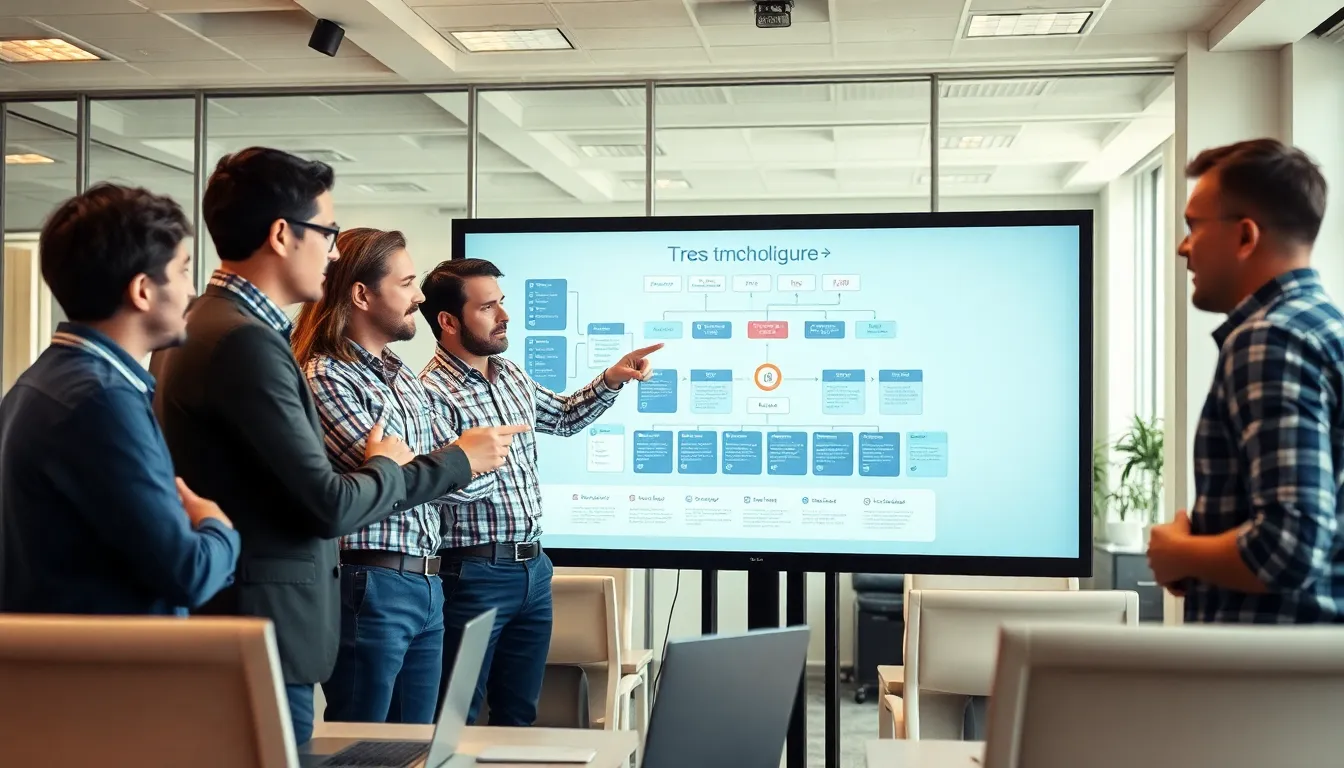Table of Contents
ToggleIn today’s fast-paced digital world, implementing tech workflows isn’t just a luxury—it’s a necessity. Picture a well-oiled machine, where every cog turns smoothly and efficiently. Now imagine that machine running on coffee and sheer willpower. Not quite the same, right? Streamlining workflows can transform chaos into clarity, letting teams focus on what really matters instead of getting lost in a sea of emails and endless meetings.
Understanding Tech Workflows
Tech workflows represent a systematic series of tasks that organize processes within digital environments. By clearly defining each stage, teams enhance productivity and establish a structured approach to their work.
Definition of Tech Workflows
Tech workflows refer to the sequence of steps that guide teams through completing a specific task or project. They often involve various tools and software designed to facilitate efficiency. Specific examples include content creation workflows or development workflows, each tailored to meet distinct operational needs. Understanding these workflows involves recognizing the individual components, such as input, processing, and output stages. Such definitions clarify the roles each team member plays, enabling streamlined collaboration.
Importance of Implementing Tech Workflows
Implementing tech workflows significantly improves team organization and efficiency. Such systems help reduce clutter, minimizing distractions from excessive emails and meetings. Organizations experience increased clarity as workflows delineate responsibilities and expectations. Teams working within established frameworks can focus on core competencies instead of disrupting tasks. Data shows that companies utilizing structured workflows witness productivity boosts, enhancing project turnaround times. Adopting workflows provides a competitive advantage in a fast-paced digital landscape.
Steps to Implement Tech Workflows

Effective implementation of tech workflows involves several critical steps that enhance organizational efficiency. Each step builds upon the previous one, creating a cohesive system that promotes productivity.
Assessment of Current Processes
Assessing current processes is essential for understanding existing workflow inefficiencies. Start by mapping out all current tasks and identifying bottlenecks. Analyze data from team feedback and performance metrics to pinpoint areas needing improvement. Gathering input regarding frustrations with current practices aids in shaping the new workflow. Engaging with team members ensures that their insights contribute to the assessment process, fostering a collaborative environment.
Identifying the Right Tools
Identifying the right tools is crucial to developing a suitable workflow. Research various software options that align with the team’s specific needs. Consider project management platforms, communication tools, and automation software that enhance collaboration. Analyze features, pricing, and user reviews to find the best fit for the organization. Testing selected tools through trial programs helps determine their effectiveness before committing fully.
Training Team Members
Training team members on new workflows ensures everyone is equipped to engage with the system effectively. Conduct workshops or webinars to introduce new tools and procedures. Emphasize the benefits of the new workflows, addressing any concerns team members may express. Providing ongoing support and resources fosters confidence in using new systems. Creating a feedback loop allows team members to share experiences and suggest improvements, further refining the workflow.
Best Practices for Successful Implementation
Implementing tech workflows requires adherence to several best practices that enhance overall efficiency and effectiveness. Continuous feedback and integration with existing systems form crucial aspects of this process.
Continuous Feedback and Improvement
Gathering feedback from team members ensures the workflow remains relevant and effective. Establish regular check-ins to assess how the workflow performs, making adjustments based on team input. Encourage an open culture where suggestions for improvements are welcomed and valued. Tracking progress through metrics assists in identifying areas that require enhancements. This cycle of continuous improvement drives engagement and aligns the workflow with team needs.
Integration with Existing Systems
Prioritizing the integration of new workflows with existing systems maximizes efficiency. Evaluate current software and processes to ensure compatibility before implementation. Streamlined connections between tools facilitate smooth transitions and reduce friction. Address potential technical challenges early in the integration process. Achieving a cohesive ecosystem not only minimizes disruptions but also leverages existing resources effectively, fostering an environment where teams can focus on their core responsibilities.
Challenges in Implementing Tech Workflows
Implementing tech workflows presents various challenges that organizations often face. Recognizing these obstacles is essential for successful integration.
Common Obstacles
Disorganization can arise during the transition to new workflows, leading to confusion among team members. Resistance to change frequently occurs when employees are accustomed to established processes. Additionally, inadequate training may leave teams unprepared to adopt new tools, resulting in decreased productivity. Teams may also struggle with selecting the appropriate software that meets their specific needs. Ensuring compatibility with existing systems is another hurdle that can hinder effective implementation. A lack of clear communication about workflow changes often compounds these challenges.
Strategies to Overcome Challenges
Addressing these challenges requires strategic approaches. Establishing a clear communication plan can keep all stakeholders informed and engaged. Providing comprehensive training sessions equips team members with the skills needed to utilize new tools effectively. Gathering feedback during the implementation phase allows for adjustments based on real-time experiences. Pairing team members with workflow champions simplifies the adaptation process by offering support and guidance. Testing workflows before full implementation helps identify potential issues, ensuring smoother transitions. Fostering a culture that embraces change encourages acceptance and collaborative problem-solving.
Implementing tech workflows is a game changer for organizations aiming to boost efficiency and productivity. By streamlining processes and reducing distractions, teams can focus on what truly matters. The right tools and ongoing training empower team members to adapt seamlessly to new systems.
Embracing a culture of feedback and continuous improvement ensures that workflows remain effective and relevant. As organizations navigate the complexities of the digital landscape, a structured approach to workflows not only enhances collaboration but also positions them for success. Adopting these practices will lead to a more organized and agile environment, ultimately driving better results and a competitive edge.







